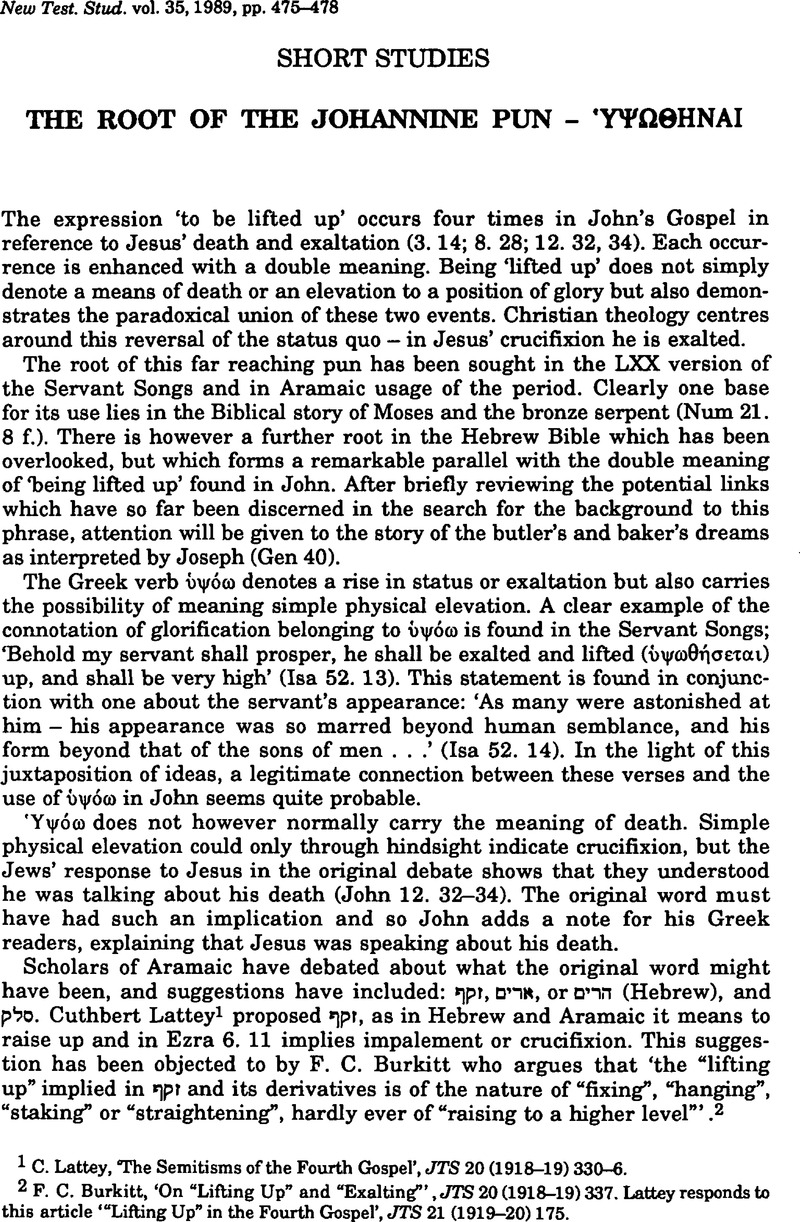Article contents
The Root of the Johannine Pun – 'ΥΨΩΘНΝАΙ
Published online by Cambridge University Press: 05 February 2009
Abstract

- Type
- Short Studies
- Information
- Copyright
- Copyright © Cambridge University Press 1989
References
page 475 note 1 Lattey, C., “The Semitisms of the Fourth Gospel’, JTS 20 (1918–19) 330–6.Google Scholar
page 475 note 2 Burkitt, F. C., ‘On “Lifting Up” and “Exalting”’, JTS 20 (1918–19) 337.Google Scholar Lattey responds to this article ‘“Lifting Up” in the Fourth Gospel’, JTS 21 (1919–20) 175.Google Scholar
page 476 note 1 Burkitt, 336–8. Supported also by Bonsirven, J., S.J., ‘Les Aramaismes de S. Jean L'Evangeliste?’ Biblica 30 (1949) 430.Google Scholar
page 476 note 2 McNamara, Martin, The New Testament and the Palestinian Targum to the Pentateuch (Rome: Biblical Institute Press, 1978) 145–9.Google Scholar
page 476 note 3 Torrey, C. C., ‘When I am Lifted Up From the Earth’, JBL 51 (1932) 320–2.Google Scholar
page 476 note 4 McNamara, , The NT and the Palestinian Targum to the Pentateuch, 149.Google Scholar
page 477 note 1 It is worth noting that the three-day time frame in Gen 40 at the end of which period both the butler and the baker were to be lifted up is reminiscent of the three days before Jesus' resurrection.
page 477 note 2 Bertram, George, ‘ύψόω’, TDNT 8, 606–13.Google Scholar
page 477 note 3 For the above I am dependent on Kaiser, W. C., ‘![]() ’, Theological Wordbook of the Old Testament, Vol. 2, ed. Has, R. L. (Chicago: Moody Press, 1980) 600–2.Google Scholar
’, Theological Wordbook of the Old Testament, Vol. 2, ed. Has, R. L. (Chicago: Moody Press, 1980) 600–2.Google Scholar
page 478 note 1 Kaiser, , ‘![]() ’, 501.Google Scholar
’, 501.Google Scholar
page 478 note 2 Cf. Burney, C. F., The Aramaic Origin of the Fourth Gospel (Oxford: Clarendon Press, 1922) esp. 114–25.Google Scholar The quotations used in John's Gospel are predominantly from the Hebrew Bible, and where they reflect the LXX they have been altered at a later date to do so. Also Bonsirven, J., ‘Les Aramaismes de S. Jean L'Evangeliste?’, Biblica 30 (1949) 432.Google Scholar He notes that Aramaisms are particularly found in the passages where Jesus is speaking.
- 1
- Cited by


